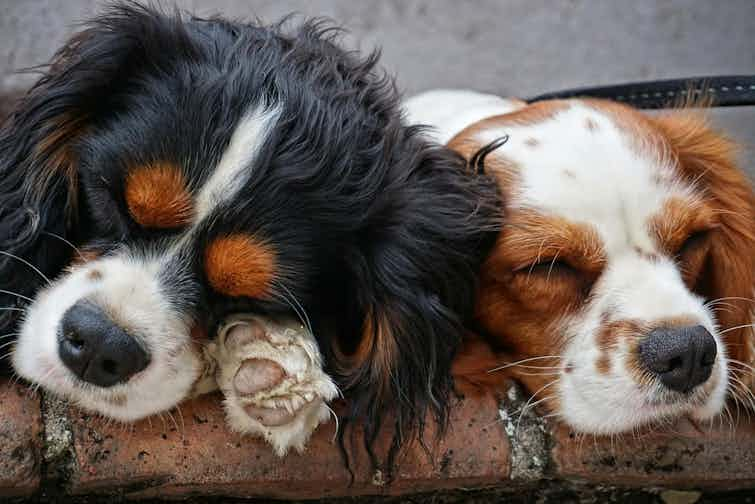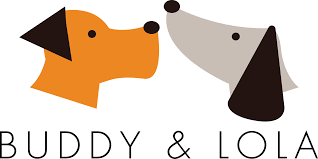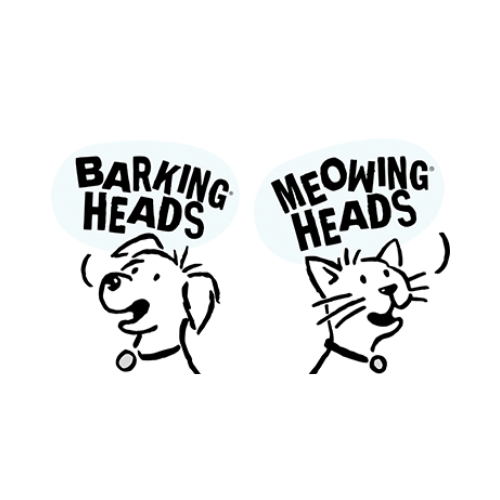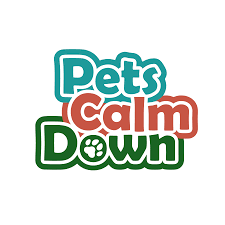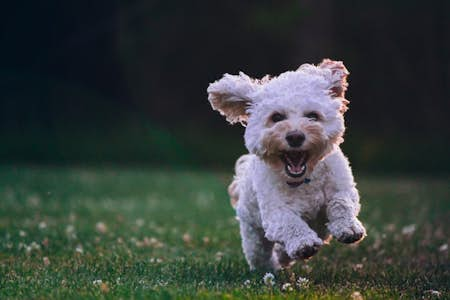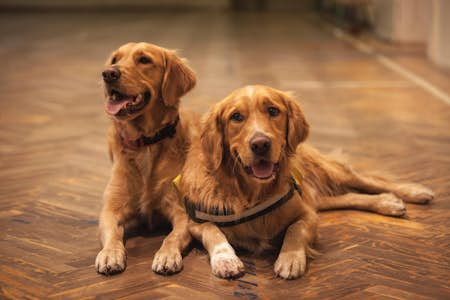Not all dog breeds are equal. While they most obviously vary by looks, they also vary by mentality. It is that mentality that sometimes affects their confidence or need for exercise. Beagles, for example, are known to need lots of exercise. Cockapoos are meant to be loving mongrels but are full of excitable energy for much of their lives.
However, many dog breeds are known to be calm. Calm dogs can be an excellent addition to any household. They provide companionship without the need to walk them for miles on end or play with them for hour after hour. Calm dog breeds can therefore be a great option if mobility is an issue for you. Or, perhaps your primary motivation for getting a canine pet is friendship.
Here, we identify 22 of the calmest dog breeds around and look at ways to encourage calm behaviour in any dog, regardless of breed.
Whether you're looking for a tailored diet solution for your furry friend or are looking for better value from your pet food shopping, our providers have various options to help meet your needs. Click a brand below to discover more of what they offer!
Calm dog breeds
The following dog breeds are usually sedate and calm. Of course, there will always be anomalies to every breed, but thorough and consistent training should be able to bring out the best in any dog.
Newfoundland
These huge animals may initially put you off due to their size. However, while they are big, they are also pretty placid animals. Moving their bodies sometimes seems to be such an effort that you will see them sit or lie down frequently. They move slowly when they are on the move, thanks to that relaxed demeanour.
So, while Newfies may need a lot of food and a fair bit of grooming, they are also excellent, real-life teddy bears for companionship. If you’re looking for a giant, cuddly couch potato, this is the dog for you.
Labrador Retriever
One of the nation’s favourite dogs, the labrador retriever, may not be the calmest of puppies. Still, after some training, owners find them to be brilliant pets. They are loyal to a fault, and as a result, they will often respond to how their owner is feeling.
If you are not feeling up to going out for a walk, a lab will happily sit at home with you. Plus, you can train them not to bark whenever the doorbell rings or jump up on a guest when you have friends around.
Greyhound
While greyhounds are known for their speed and agility, they are incredibly tranquil animals. And, if you find a place to walk them with lots of open space, you do not necessarily have to walk too far for them to get the level of exercise they need. Take a ball and a thrower for them to chase after, and they will soon exhaust themselves running in short, fast bursts.
Buying an ex-racing greyhound is an excellent option as it gives a home to a dog in need of one. Plus, they will often be trained already, taking out some of the hard work of owning a puppy.
Golden Retriever
The golden retriever has many similarities and character traits to a labrador. Calm and composed, these dogs are among the best family pets you can bring into your home. Their coat, which can moult and needs regular maintenance, can put some people off these dogs. However, most golden retriever owners cannot imagine a better dog.
Their peaceful composure and the ease with which you can train them means they are perfect if you're looking for a reliable dog that won't bring crazy antics into the home.
Cavalier King Charles Spaniel
This beautiful breed is often a crowd-pleaser at dog shows. One of the reasons they do so well at shows is their temperament, which is calm and serene. They are friendly, too, so they can be a great addition to a home with children or often visiting grandchildren.
Like other long-haired dogs on this list, some potential dog owners may be discouraged from buying a King Charles due to the maintenance their coats need. However, the joy these loving creatures bring to your home means that owners often love the grooming process. It gives you an excuse to shower your four-legged best friend with love and attention!
Pug
This tiny dog breed is an excellent option if you're looking for a pup that is calm and exhibits many other low-maintenance qualities. Pugs do not need much walking and don't suffer too badly from separation anxiety. So, if there are days that you do have to leave them at home for a few hours, they will remain calm and not find being left alone too stressful as other dog breeds may well do.
Their squat face may not appeal to everybody and can cause them serious breathing problems. As a result, many vets are now campaigning against breeding these small dogs because so many have respiratory illnesses that can cause severe issues.
Despite this, pugs have become popular in recent years thanks to their gentle and loving ways. So, if you're considering a pug to become your furry friend, why not adopt an older pug instead of buying a puppy? That way, you can rest assured that you’re giving a kind home to a pup in need.
Great Dane
In stark comparison to a pug, we have one of the dog world's biggest breeds. But a Great Dane is also a good choice if you're looking for a calm dog. Originally bred as a hunting dog, Great Danes descend from a cross between a Mastiff and an Irish Wolfhound.
Their ability to learn from and obey their owners makes them popular on hunts. That intelligence also makes them a dog that is quick to pick up training, so you can teach a Great Dane to be calm in all situations.
English Bulldog
This little brute of a dog remains a firm favourite in dog-loving nations. The reason being is that they are known to be very kind and patient, which seeps into them often having a composed nature.
Like pugs, their squat faces may not be for everyone and can mean they suffer breathing problems. However, they do not require very long walks and will remain calm at home even if they have not been out all day. Their short hair also means they do not need many baths or trips to the groomers.
Shih Tzu
While some dog owners will buy a Shih Tzu to grow their hair long for dog shows, many buy them for simple companionship. If you do, you will find them to be a wonderful friend who is receptive to your mood.
If you want to play or do something energetic, they will keep up with ease, but they are also just as satisfied with a good cuddle on the sofa.
Even Shih Tzus with shorter coats will need some level of grooming, but much like the Cavalier King Charles Spaniel, owners usually love spending quality time with their pup.
Shar Pei
The furrowed brow and face of a Shar Pei make them easily identifiable dogs. Their short coats immediately make them that bit easier to look after. But it is their temperament that always wins over their owners.
These gentle giants are laid back and relaxed in almost all scenarios. Plus, while they love a walk and an excuse to get outside to have a good sniff, they are equally just as happy to stay at home with their favourite toy.
Rebecca Walters from Pupstarts Breeders told us: "When considering the addition of a dog, it is important to factor in your requirements and expectations from dog ownership and match that to a breed known for fitting those factors. Ensuring the right match of expectations from you, and the needs of the breed in question, will make the journey of dog ownership a happier and much more enjoyable one, for both you and the dog!"
Basset Hound
If you’re looking for a family dog, a Basset Hound makes a great option. These lovely pups are great with children and other dogs, especially at playtime. They can be energetic when they want to, but for the most part, they’re a calm and well-natured breed (and usually enjoy a nice long nap once they've been out!).
They have a distinctive appearance, with long, floppy, velvety ears and big mournful eyes. They don't usually grow any taller than 30 centimetres or so (about 12 to 14 inches), but they're pretty powerful despite their diminutive size.
Basset Hounds are an excellent choice for anyone who wants the personality of a big dog in a small dog’s body.
French Bulldog
Frenchies are another breed with a squashed face – again, some people love this, but others aren’t so keen. However, they have a lovely temperament that can make these dogs a fantastic addition to your family.
They're an affectionate breed, and they love to snuggle up for a cuddle, making them ideal lap dogs. They also tend to keep pretty quiet, so you can rest assured that they probably won’t keep you awake barking all night – though they might not make the best guard dogs!
Pekingese
The American Kennel Club (AKC) refers to these tiny little Pekingese pups as "regal in manner", and it's not hard to see why. These sleek dogs have long and luxurious fur coats, giving them a striking appearance. They were actually initially bred for royalty in Ancient China!
Their long double coats can mean a fair amount of grooming is necessary, but it’s worth it if you want an affectionate and loyal dog in your life.
Pekingese also make good watchdogs, as they’re highly alert and will be sure to let you know if something is amiss!
Saint Bernard
If you’re in the market for a big dog instead of a little'un, then a Saint Bernard could be an excellent choice. This breed can weigh as much as 80 kilos (about 12 and a half stone), so it’s no small fry. You’ll need plenty of room to house one of these gentle giants and enough energy to take it for some long walks!
Saint Bernard dogs hail from the Swiss and Italian Alps originally, as they were bred for mountain rescue work. They have a lovely temperament and are excellent with children. If you’re wondering why they seem familiar, it’s because a Saint Bernard was Nanny in Peter Pan – if that’s not proof that they’re great with kids, we don’t know what is!
Drool can be an issue for some people, but this dog is an excellent companion if you don't mind that too much. Calm, loving and social.
Boerboel
Another large dog, the Boerboel is a type of mastiff. They can be intimidating if you're not a dog person, but they have a surprisingly calm and laid-back demeanour.
For a mastiff, the Boerboel is surprisingly quick and agile. They do have a fair amount of energy, so like most big dogs, they’ll need long walks and plenty of games to keep them fit and healthy. The Boerboel can also be quite a dominant breed, so it’s good to get them used to socialising – both with other dogs and with people – from a young age.
Boerboels can also be a little territorial, so it’s good to be wary if you’re taking them to a dog park or to play with other dogs. But with regular training and socialisation, these dogs are lovely, loyal pets that will remain calm while you’re at home.
Clumber Spaniel
Although not as well known as other spaniel breeds, the Clumber Spaniel is an excellent choice of dog if you’re looking for a calm dog breed. They’re the largest of the spaniel breeds, and they have a slightly Labrador-esque look to them – if you’re looking for a dog with a friendly face, this is a great choice!
These are affectionate dogs, especially with their owners. If you give one of these dogs a lot of love, they’ll be sure to return the favour. They’re also intelligent and tend to enjoy being trained – but it can be tricky to train them, as they’re often too smart to want to follow orders!
They tend to keep quiet and calm in the house, but they enjoy a runaround, so make sure you have time to take them outside for a walk or to play. They also have pretty long, thick fur that requires regular grooming to look its best.
Bernese Mountain Dog
A Berner might not be the best dog if you’re looking for an apartment dog or a lap dog, but they certainly make a fantastic pet for people with enough space.
They have a similar appearance to a Saint Bernard in terms of size and gait – and that makes sense, given that they share similar roots in the Swiss Alps. Bernese Mountain Dogs are slightly smaller and lighter, though, and they don’t have such a droopy face as a Saint Bernard.
Like Saint Bernards, though, Bernese Mountain Dogs are working dogs, requiring a good deal of exercise and playtime. Drool can be an issue for some Berners, but if that’s not an issue for you, you’re all set.
Berners certainly make up for what they lack in decorum in personality and charm. They're great with children and people, but they often have a favourite with whom they'll be extra affectionate. They also seem to enjoy pulling children along in carts, so if you've got grandkids, they're sure to become friends pretty quickly!
Scottish Deerhound
The Scottish Deerhound is a bit like a larger, shaggier Greyhound. In fact, they're distant cousins, so that makes sense. These gentle dogs might look a bit shabby with their wiry coats, but they have a very polite temperament that makes them firm favourites among people in the know. This breed is the “royal dog of Scotland” and was bred to hunt wild red deer with their noble owners.
They’re incredibly fast – they can be even faster than a Greyhound if given enough space to pick up speed. With that in mind, you’ll want to make sure you have enough time to take your Deerhound for some long walks, ideally somewhere off the lead, so they can really stretch their legs.
Deerhounds are not a good choice for people who live in a city, as they thrive most when they have the space to run around freely.
Personality-wise, the Scottish Deerhound is an incredibly affectionate and friendly dog. They come across as quietly dignified, with a docile temperament.
Bergamasco Sheepdog
As you might expect from the name, the Bergamasco Sheepdog is a herding breed. Another dog with origins in the Alps, this striking breed has a highly unusual coat that sets it apart from other sheepdogs. The coat is shaggy, long and thick, but what’s unique about it is that it clumps together in matted locks, particularly in the hind legs. This is to protect it from the cold mountain air of the Alps.
The Bergamasco Sheepdog is a moderate- to high-energy breed, as are most shepherd breeds. They love spending time outside with their owners, as they’re incredibly social creatures that prefer company over alone time.
Tibetan Spaniel
If you’re looking for something smaller, a Tibetan Spaniel is another calm dog breed that could be a good choice. They have a playful personality, and they tend to form a close bond with their owners.
The Tibetan Spaniel is not, strictly speaking, a spaniel breed. Real spaniels are gun dogs, but this breed is actually a companion dog – safe to say, it makes a great little pal to have running about your house!
These dogs don't like being left alone, so it's a good choice if you’re looking for a fast friend that you can take with you when you go out. Thanks to its small size, it's not too difficult to do this, as it's pretty unintrusive. It can, however, be a bit jittery around new people, so fair warning that things could get noisy on your outings!
Whippet
Whippets are lovely dogs. They're a relatively popular dog breed and another one that’s descended from the Greyhound. They’re very similar to Greyhounds in appearance, just slightly smaller. They're also lightning fast, and they love to run around. They're very agile and streamlined thanks to their build, meaning that they're the quickest dog breed for their size.
Although they love running around, they enjoy lounging about and relaxing after exercise. They're great house pets and don't even mind living in apartments or cities as long as they get enough walks.
Whippets are calm and gentle, very affectionate and excellent with both other dogs and children. They can be pretty cheeky, though, so it's best to keep your eye on them if you're letting them off the lead!
Pyrenean Mountain Dogs
If you’re looking for a working dog, a Pyrenean Mountain Dog makes an excellent choice. Also known as the Great Pyrenees, the Pyrenean Mountain Dog has a pretty similar appearance to a pale-coloured Golden Retriever, but it’s larger and makes a slightly better guard dog.
As the name suggests, this breed originally comes from the Pyrenees mountain range in France. It's a large breed with a fluffy coat, usually white with brown or grey markings. They're incredibly strong and often used by shepherds who want to protect their flock from wild animals like wolves, bears and coyotes.
Despite their thick, luscious coat, Pyrs don't need too much grooming, which certainly adds to their appeal. That said, they do shed at certain times of the year, and you’ll definitely notice, as it’s a lot of fur to lose!
This breed is also quite happy with only moderate exercise, so regular walks are needed. Still, these don't have to be too long if you're leading a busy life. Pyrs are intelligent, but they can be very stubborn, making training a bit more of a challenge than you might expect. The best option here is to start training them at a young age.
Overall, though, these dogs are calm in the house, affectionate by nature, and great for a cuddle. They get on well with families and children, so they should do well when you bring the grandkids over for a visit.
Ways to encourage calm behaviour in a dog
If you already have a dog and find that they are not calm at all, it is possible to change the status quo. Do not just write it off as down to their breed or that you think them impossible to train. There are several ways you can encourage calm behaviour in any dog, which you may find helpful.
Positive enforcement
We often think training a dog involves little more than teaching them to sit or rollover. We usually teach these through positive reinforcement – either through rewarding them with food or a toy when they have done as you have asked.
You can do the same when it comes to rewarding calm behaviour. If your dog does not jump up when you walk in the door or does not bark at the postman, reward them.
Practice, practice, practice!
Once you have done a little bit of positive reinforcement training with your dog, do not stop there, you need to keep going. While some dogs pick things up very quickly, others do not and may take some time to get to grips with what you believe to be acceptable behaviour.
Training your dog does not have to be onerous. Just see it as spending quality time with them. Do short sharp bursts as often as you can.
Regular exercise
While some dogs do not need much exercise to stop them from wrecking the inside of a house when left alone, others do. If you fall into this remit, try walking your dog a little more every day or even employ a dog walker if you do not quite have the stamina for yet more walking.
Excitable or negative behaviour often comes from boredom, so if they are tired, they do not have the chance to get up to mischief.
Having a calm dog breed
Researching a dog breed before buying a dog is so important. The chances of getting the right dog for your family are materially improved if you choose a breed that will be predisposed to meeting your needs.
So, if you need a calm dog, for whatever reason, ensure that you don't choose a breed known to be excitable. Otherwise, you could find that you and the dog are not as happy as you could be, even though you love one another deeply.

